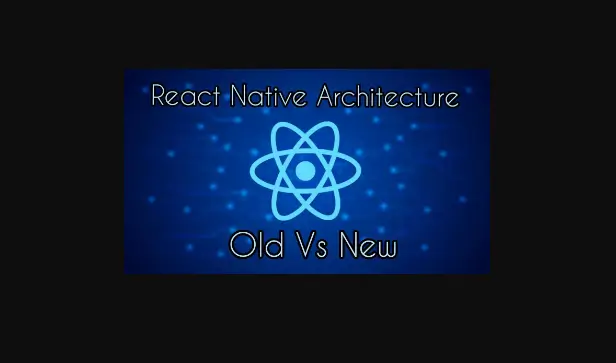ReactNative New vs. Old Architecture: Comparison.
Demystifying the Old Guard: Unveiling React Native’s Legacy Architecture
Before venturing into the future, let’s rewind and revisit the bedrock of React Native: its classic architecture. Remember that catchy slogan, “Learn once, write anywhere?”
That’s the magic spell cast by this JavaScript library, letting you conjure mobile apps that dance across both Android and iOS stages.
But how does this UI wizardry work? Buckle up, as we peel back the layers:
Native Views Take the Spotlight: Unlike a direct, code-to-code translation, React Native leverages native components (think building blocks for Android’s Java or iOS’s Objective-C/Swift) to paint your app’s interface.
This native touch translates to smoother performance and a delightful user experience.
Components in Conversation: React Native builds your UI by stacking blocks called components. They chat with each other using “props” (like little gift boxes) and “callbacks” (think “call me back!” whispers). This one-way street keeps data flowing predictably, simplifying your app’s inner workings.
Passing the Data Baton: Need something from your app’s junior component? Send down a callback, like a baton in a relay race. And if junior needs something from you, you’ll find it neatly wrapped in a “prop” – no messy back-and-forth required. This one-direction path makes your app design and maintenance a breeze.
Native Friends Welcome: While React Native champions its own component creations, it embraces native friends too. Need a fancy MapView? Simply integrate it seamlessly! React Native’s friendly bridge facilitates smooth communication between your JavaScript code and these native superstars.
Decoding the JavaScript Jargon: Your phone’s operating system speaks a different language – native code, not JavaScript. So, React Native acts as the interpreter, reading your JavaScript, executing it, and using its bridge to whisper instructions to the native components, who ultimately paint the UI magic on your screen.
This is just a glimpse into the old architecture’s inner workings. Remember, even though a newer version shines today, understanding the foundation is crucial for both appreciating its evolution and mastering React Native’s full potential.
From Code to Mobile Magic: Unpacking React Native’s Bundling Process
Building native mobile apps used to be a language-specific odyssey. Android meant diving into Java, while iOS demanded mastering Objective-C or Swift. But React Native changed the game with its “learn once, write anywhere” promise. Now, JavaScript becomes your passport to both platforms, even if you need to occasionally venture into native territories for unique features.
But how does this cross-platform sorcery work?
Let’s peel back the curtain and reveal the hidden workings of React Native’s bundling process.
1. Code Gathering: Imagine your React Native project as a sprawling city. Your JavaScript code forms the bustling downtown, while separate “android” and “ios” districts house platform-specific code that bootstraps React Native.
2. JavaScript Bundling: Enter the packager, your efficient city planner. It gathers all your JavaScript code – from the bustling downtown to the quiet suburbs – and packs it into a single, neatly organized file called main.bundle.js. Think of it as a travel visa for your code, ready to hop onto either Android or iOS devices.
3. Platform Bootstrapping: Now, let’s say you want to launch your app on Android. You run yarn android, and the magic begins! The native entry point in the “android” district springs into action, launching a JavaScript virtual machine (VM) in a background thread. This VM is your app’s interpreter, ready to understand and execute your bundled JavaScript code.
4. JavaScript on the Road: Your main.bundle.js takes center stage within the VM, ready to execute instructions. But navigating the mobile world requires a guide – the React Native bridge. This acts as a translator, ensuring smooth communication between your JavaScript code and the native Android (or iOS) environment.
5. JavaScriptCore: The Mobile Interpreter: But how does your phone understand this JavaScript talk? That’s where JavaScriptCore comes in. This framework serves as the mobile interpreter, allowing your bundled JS code to run smoothly on the device. On iOS, it’s built-in, while Android gets a bundled version from React Native.
Debugging Tip: Remember, debugging in Chrome uses a different engine (V8) and communicates with native code via WebSockets. This can lead to discrepancies compared to the on-device experience with JavaScriptCore. So, keep this dual-engine reality in mind when hunting down elusive bugs!
With this understanding of React Native’s bundling process, you’re well-equipped to navigate the fascinating world of building cross-platform mobile apps. Remember, it’s a journey of code, packing, translation, and interpretation, all working together to make your app dreams a reality on both Android and iOS!
Bridging the Gap: Unveiling React Native’s Communication Channel
The React Native bridge: a crucial yet hidden player in your app’s performance. Written in Java/C++, it acts as the translator between your app’s main (native) thread and the JavaScript realm where your code lives.
But how does this magical exchange work?
From Code to Canvas: Let’s imagine your app as a bustling marketplace. Your JavaScript code dictates what needs to be displayed – think “fresh fruit stand” and “vibrant flower stall.” This message travels across the bridge, not as shouts across the square, but as neatly serialized JSON packets.
Shadow Play: But before these stalls materialize, the “shadow thread” steps in. This hidden helper calculates the perfect placement for each element, ensuring your market layout is visually harmonious. The results? Packed into the same JSON message and whisked back to the main thread.
User Actions Take the Stage: Now, imagine a customer browsing your market. Any tap, swipe, or button press is captured by the main thread, transformed into another JSON message, and sent on its bridge journey to the JavaScript thread. Here, your app’s core logic takes over, deciding what happens next.
Performance in the Marketplace: So, how does this constant back-and-forth affect your app’s speed? In typical usage, the bridge handles communication swiftly, ensuring a smooth customer experience. But remember, like a crowded market, excessive bridge traffic can cause delays.
Native Advantage: Unlike some other platforms, React Native doesn’t rely on a clunky “WebView” – it builds directly with native components. This translates to smooth, 60-FPS interactions that delight your users. However, remember the market analogy: frequent updates from deeply nested components (think overflowing stalls) can cause hiccups, especially if they involve complex calculations.
Bridging Insights:
- The React Native bridge facilitates communication between native and JavaScript threads.
- Serialized JSON messages carry information about UI rendering and user actions.
- The shadow thread helps optimize UI layout calculations.
- Native components contribute to smoother performance compared to platforms like Cordova.
- Re-rendering complex components deep in the hierarchy can impact performance.
By understanding the React Native bridge’s role, you can optimize your app’s communication flow and ensure a seamless user experience, even in the busiest of mobile marketplaces.
React Native Stage: A Backstage Walkthrough
Imagine your React Native app as a bustling theatre performance. Behind the curtain, a fascinating interplay between languages and threads drives the show. Let’s peek behind the scenes:
The Cast:
- JavaScript Bundle: All your JavaScript code lives here, the script that orchestrates your app’s logic and behavior.
- Native Code: Like backstage crew, native modules handle tasks like UI rendering and interactions, specific to each platform (Android or iOS).
- Threads: The stagehands! You have three teams:
- JavaScript Thread: Runs the JavaScript Bundle, keeping the logic flowing.
- Native/UI Thread: Handles all things visual, painting the UI on the screen and responding to user gestures.
- Shadow Thread: A hidden helper, pre-calculating element layouts for smooth rendering.
The Bridge: Connecting the Worlds:
To bridge the gap between JavaScript and native worlds, we have the bridge. Think of it as a translator, taking messages from one side and converting them for the other. These messages, carrying instructions and data, are:
- Batched and optimized: Bundled efficiently to avoid chatty back-and-forth.
- Serialized as JSON: A universal language both sides understand.
Communication Flow:
- JavaScript needs something from a native module (Bluetooth, say)? It whispers a request to the bridge in JSON.
- The bridge tidies up and relays the message to the native thread.
- Native code takes the stage, performs the requested task, and sends a response back through the bridge.
- Finally, the bridge translates the response and delivers it back to the JavaScript thread.
Asynchronous Harmony:
This communication happens “asynchronously,” like actors waiting for their cues. It generally works smoothly, but remember:
- No real-time conversations – messages take time to travel across the bridge.
- Sometimes, JavaScript and native code need to be in sync. Luckily, React Native has tools to handle these special cases.
Understanding this backstage performance empowers you to:
- Optimize your app’s communication flow for smoother experiences.
- Leverage the strengths of both JavaScript and native worlds.
- Avoid potential performance bottlenecks by being mindful of bridge traffic.
With this knowledge, you’re ready to direct your React Native app to a truly stellar performance!
This revised version aims to:
- Use engaging metaphors and vivid imagery to explain complex concepts.
- Break down the information into a clear and concise narrative.
- Highlight key takeaways and communication flow.
- Maintain a tone that is informative yet approachable.
Bridge Out, JSI In: React Native’s New Communication Hub
Remember the bridge in the old React Native architecture? The one shuttling messages between JavaScript and native code like a tireless courier? Well, buckle up, because with the New Architecture, it’s getting an upgrade! Enter the JavaScript Interface (JSI) – a sleek, lightweight C++ layer that lets JavaScript directly call native methods, no bridge needed.
Universal Appeal: Unlike the bridge, JSI isn’t locked in a JavaScriptCore romance. It’s free to mingle with other engines like Chakra, v8, and Hermes, making it truly “general-purpose.” Think of it as a language-agnostic translator, speaking fluently to both JavaScript and native code, regardless of the engine under the hood.
Direct Line to Native Power: How does this magic work? JSI introduces C++ Host Objects as middlemen. These act like bridges between JavaScript and native modules, allowing JavaScript to grab references and directly call methods on them. Imagine it like this:
- You have a JavaScript variable called “camera” holding a reference to the actual camera module in C++.
- When you call
camera.takePicture(), JSI seamlessly relays the request to the C++ camera object, capturing that perfect shot without any bridge delays.
Breaking Free from the Bridge Chains: This direct access is a game-changer. Unlike the old bridge’s one-way street, JSI allows for a two-way conversation. JavaScript can not only call native methods but also receive responses directly, opening doors for tighter integration and real-time interactions.
Performance Boost on the Horizon: No more message serialization and deserialization – the JSI’s streamlined communication promises a dramatic performance boost. Think smoother animations, faster reactions, and an overall app experience that feels silky smooth.
Evolving the Ecosystem: JSI doesn’t just improve speed; it opens doors for the entire React Native ecosystem to flourish. New, innovative engines and native modules can now join the party, pushing the boundaries of what’s possible.
In essence, JSI is more than just a communication upgrade; it’s a catalyst for a brighter future of React Native. With its flexible, direct interaction between JavaScript and native code, the possibilities are endless!
Breaking Free from Bridge Bonds: Introducing JSI and Fabric in React Native’s Bright Future
React Native is pushing the boundaries, and the New Architecture boasts two revolutionary elements that promise to transform the mobile app landscape: JavaScript Interface (JSI) and Fabric. Let’s delve into how they’ll change the game:
JSI: Bypassing the Bridge for Direct Communication:
Imagine the bridge in the old architecture as a slow-moving tollbooth between JavaScript and native code. JSI smashes those gates! It’s a sleek, lightweight layer written in C++ that lets JavaScript directly call native methods, ditching the bridge entirely. This translates to:
- Engine Agnostic Freedom: JSI plays nice with any engine, not just JavaScriptCore. Think Chakra, v8, Hermes – the possibilities are endless!
- Direct Line to Native Power: No more message serialization delays. JavaScript interacts with native modules seamlessly, like holding a reference to the camera and snapping pictures with a single
camera.takePicture()call. - Two-Way Street: Unlike the bridge’s one-way flow, JSI allows real-time conversations between JavaScript and native code, opening doors for tighter integration and faster reactions.
- Performance Boost: Kiss clunky communication good-bye! JSI streamlines interactions, paving the way for smoother animations and overall app responsiveness.
Fabric: Reimagining the Rendering Landscape:
Fabric rewrites the rulebook on how UI is painted on your screen. Here’s a glimpse into its magic:
- Farewell, Shadowy Past: The complex shadow tree and its C++ translations become a thing of the past. Fabric works directly with JavaScript objects, simplifying the rendering process.
- Native Efficiency Unleashed: Fabric embraces native UI components, delivering smoother visuals and performance that rivals native apps.
- Declarative Delight: Developers rejoice! Fabric leverages the power of declarative API, making UI code cleaner and easier to maintain.
Combined Impact:
JSI and Fabric aren’t just individual upgrades; they’re a powerful combo redefining the React Native experience. Together, they offer:
- Unparalleled Performance: Imagine buttery-smooth animations, instant responses, and apps that feel native to the core.
- Developer Empowerment: Cleaner code, faster development cycles, and a wealth of new possibilities thanks to engine and platform flexibility.
- A Brighter Future: JSI and Fabric pave the way for a vibrant React Native ecosystem with endless possibilities for innovative apps and experiences.
New Architecture: Breaking Free from React Native’s Bottlenecks
Remember that slow bridge we all had to cross in the old React Native architecture? That clunky bottleneck that throttled communication and sucked the life out of performance? Well, buckle up, because the New Architecture is building a sleek, high-speed highway to leave those issues in the dust!
Fabric: Smooth Rendering Unleashed
Imagine painting your app’s UI like a chaotic art studio, with duplicate paint supplies scattered everywhere. Fabric throws out the clutter and embraces a streamlined approach. Here’s what it brings:
- No More Shadowy Duplicates: Say goodbye to those redundant shadow trees and separate data copies. Fabric bridges the gap between JavaScript and native UI directly, eliminating unnecessary data duplication and boosting performance.
- Native Efficiency on Tap: Fabric leverages native UI components at their core, meaning your app will feel as smooth and responsive as a native one. Animations will sing, scrolling will be a dream, and lag will become a distant memory.
- Declarative Delight: Developers, rejoice! Fabric speaks the language of declarativeness, making your UI code cleaner, more concise, and easier to maintain. Think less boilerplate, more expressive code that captures your app’s essence.
JSI: Direct Line to Native Power
Forget shouting across the bridge and hoping someone hears you. JSI opens a direct communication channel between JavaScript and native modules. Think of it like having a walkie-talkie to every native feature:
- Engine Freedom: JSI doesn’t play favorites. It works with any JavaScript engine, not just JavaScriptCore, opening doors to exciting possibilities like Chakra, v8, and Hermes.
- No More Message Delays: Ditch the serialization/deserialization dance. JSI lets JavaScript talk directly to native code, like grabbing the camera and snapping a picture with one swift
camera.takePicture()call. - Real-Time Conversations: Unlike the one-way bridge, JSI enables a two-way street. JavaScript and native code can interact in real-time, paving the way for tighter integration and faster reactions.
Turbo Modules: Smart Start-Ups
Tired of waiting for all your app’s modules to load before even saying hello? Turbo Modules change the game:
- Lazy Loading on Demand: No more pre-loading modules you might never use. With Turbo Modules, JavaScript can dynamically request specific modules only when needed, meaning your app starts up like a rocket.
- Modular Efficiency: Think of Turbo Modules as self-contained building blocks. They’re smaller, faster, and easier to maintain, making your app’s architecture cleaner and more efficient.
CodeGen: Bridging the Language Gap
Connecting JavaScript and C++ might feel like trying to speak to an alien, but CodeGen is the translator we need. This static type checker bridges the gap between dynamic JavaScript and statically typed C++ by:
- Ensuring Smooth Communication: CodeGen defines clear interfaces for Turbo Modules and Fabric, ensuring seamless communication between realms without any type mismatch confusion.
- More Native Code, Less Run-Time Overhead: CodeGen generates native code at build time instead of during app execution, further boosting performance and reducing runtime friction.
The New Architecture: A Bright Future for React Native
By combining Fabric, JSI, Turbo Modules, and CodeGen, the New Architecture isn’t just a few tweaks; it’s a complete metamorphosis. It’s about unlocking React Native’s true potential, delivering apps that are faster, smoother, and more delightful to use. So, get ready to embrace the future of mobile app development, because React Native is about to take off on a supersonic journey!
Summary
Move over, clunky bridge – React Native’s future is paved with sleek efficiency and blazing performance! The New Architecture is like a high-octane upgrade, ditching the bottlenecks and injecting a shot of adrenaline into your mobile app dreams. Let’s explore the key features that power this transformation:
1. JSI: Bypassing the Bridge Bottleneck
Imagine the old bridge as a slow tollbooth separating JavaScript and native code. JSI smashes those gates! It’s a direct communication channel, letting JavaScript talk to native modules face-to-face. No more message relay races – things get done lightning-fast!
2. Engine Freedom: Beyond JavaScriptCore
Forget JavaScriptCore’s monopoly. JSI plays nice with any engine, opening doors to exciting possibilities like Chakra, v8, and Hermes. The future of React Native just got a whole lot more diverse!
3. All Threads Sing in Harmony
No more communication silos! With JSI, all threads – JavaScript, native UI, even the shadow thread – dance in perfect sync. This translates to silky-smooth animations, instant responses, and an app that feels like a native masterpiece.
4. Fabric: Painting the Perfect UI Picture
Think of Fabric as a revolutionary paintbrush. It ditches the messy shadow tree duplicates and embraces a streamlined approach, rendering your UI directly with native components. The result? Crisp visuals, buttery-smooth scrolling, and performance that rivals native apps.
5. Turbo Modules: Lean, Mean, Loading Machines
Say goodbye to waiting for all modules to boot up. Turbo Modules are self-contained units, loading dynamically only when needed. Your app starts in a flash, leaving sluggish launches in the dust.
6. CodeGen: The Language Bridge Builder
Connecting JavaScript and C++ used to be like speaking to aliens. CodeGen is the translator, ensuring smooth communication through static type checking. No more mismatch hiccups, just seamless interaction between realms.
The New Architecture: A Future Awaits
These are just some of the groundbreaking features that empower the New Architecture. It’s not just about technical tweaks; it’s about unlocking React Native’s full potential. Imagine apps that are faster, smoother, and more delightful to use – that’s the future React Native has in store.
So, buckle up, developers! The New Architecture is taking off, and it’s time to embrace the exciting journey ahead. Let’s build the next generation of mobile apps, together!
Note: The information above might not be accepted 100%. Please verify from your own sources. We will not be responsible for any kind of loss due to our content.
For more news, please visit Munafa Marketing.




